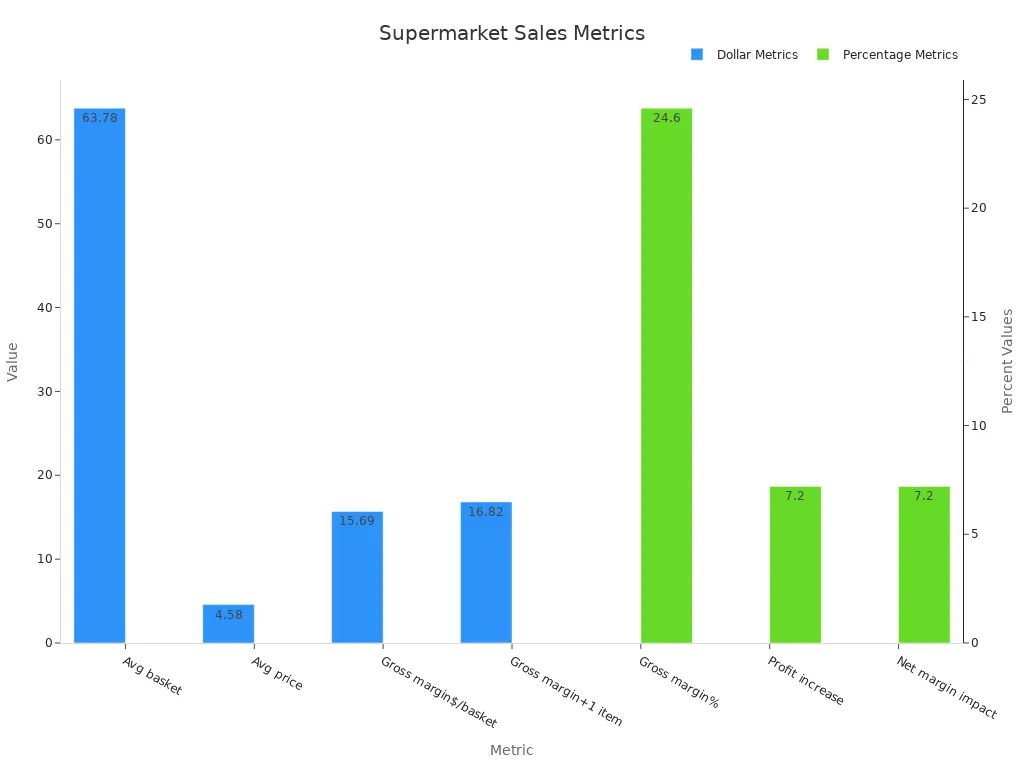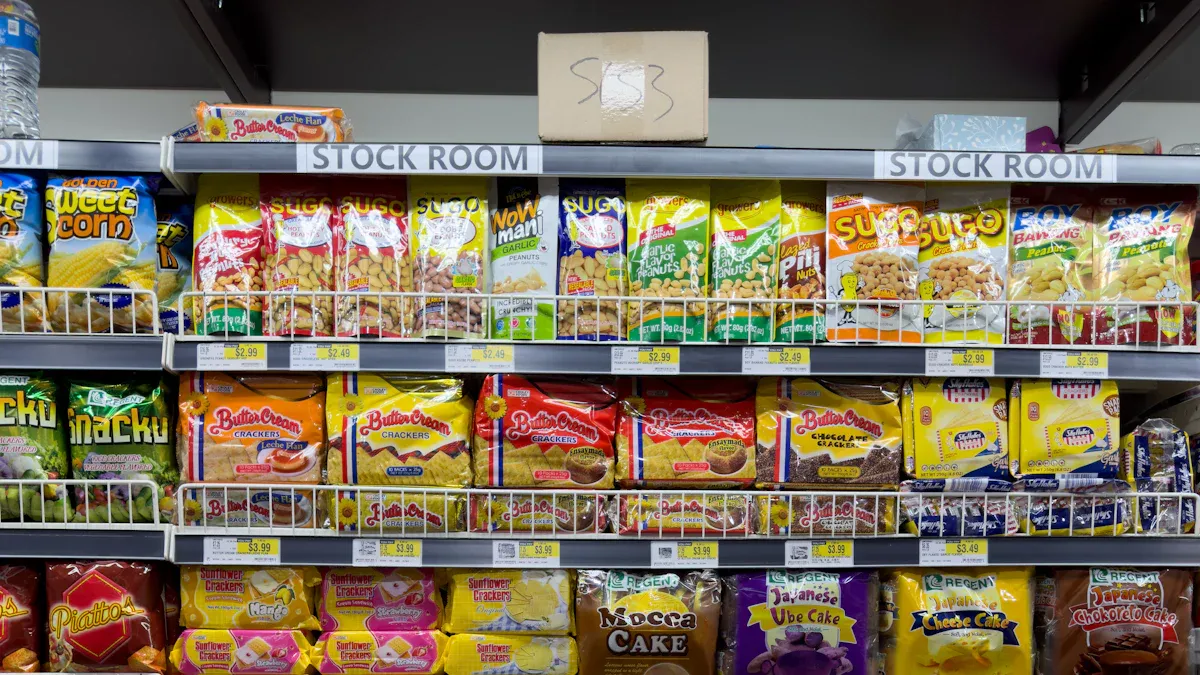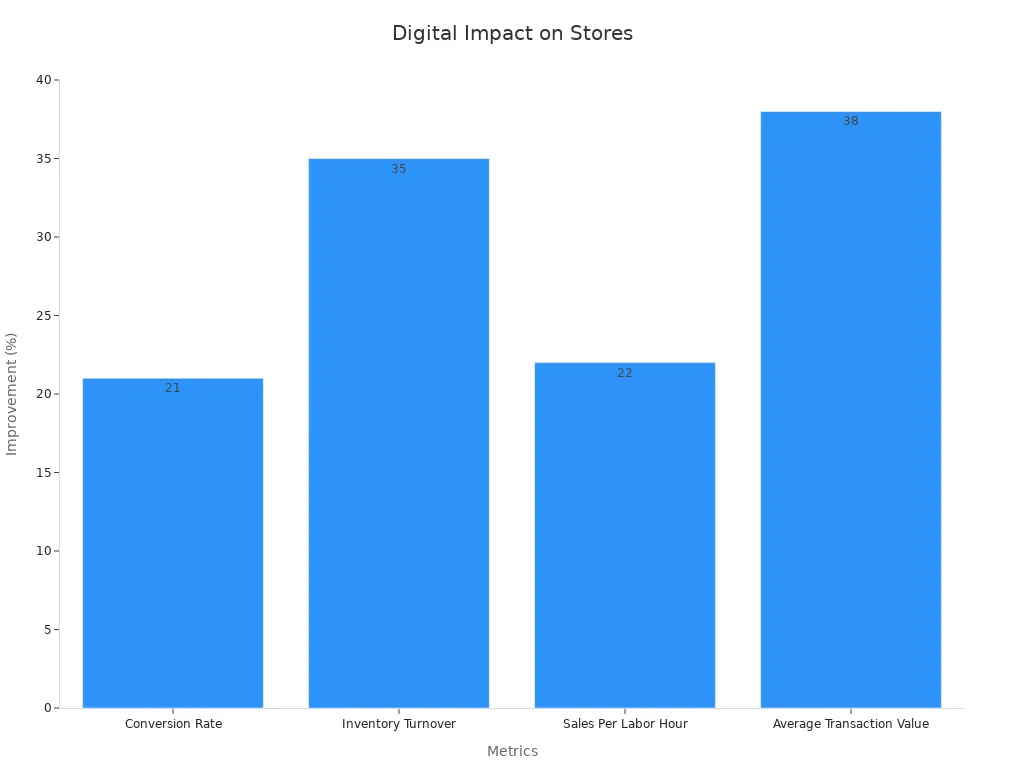
You experience shelf grocery strategies every time you walk through a supermarket. These strategies use digital platforms and data analytics, producing a 91% correlation between virtual testing and real-world customer behavior. Supermarkets design every display and aisle to maximize exposure and profit, as shown by a 7.2% profit increase when a customer adds just one more item per trip. Tools like Electronic Shelf Labels, ESL Gateway AP, and ESL Price Tag support Esl Retail operations, ensuring you see the right product at the right place.

Main Goals of Supermarket Shelf Grocery Layouts
Maximizing Product Exposure in Grocery Store Layout
Increasing Visibility of High-Margin Items
You notice that high-margin products often occupy the most prominent positions on shelves. Supermarkets use shelf grocery strategies to place these items at eye level, ensuring you see them first. Commercial eye-tracking data shows that when you focus on a product, the chance you consider buying it rises by 30% to 120%. This approach increases merchandise visibility and drives sales, especially for brands you may not recall easily. By optimizing shelf space, supermarkets improve product exposure and boost profits beyond what traditional market share metrics predict.
Ensuring Popular Products Are Easy to Find
You expect to find staple items quickly. Supermarkets design grocery store layouts so that popular products remain accessible, reducing frustration and encouraging repeat visits. When you locate your favorite items with ease, you spend more time exploring other sections, which increases the likelihood of additional purchases. This store layout strategy balances convenience with exposure to new or promoted products.
Encouraging Impulse Purchases to Increase Sales
Strategic Placement of Small, Tempting Items
Impulse buys play a critical role in increasing sales. You often encounter small, tempting products—like candy or snacks—strategically placed along your path. Research confirms that even a few impulse purchases can significantly boost overall sales and profits, especially for high-margin goods. Marketing stimuli such as displays, lighting, and price promotions prompt you to make spontaneous decisions.
- Retailers place impulse products near checkout areas to tempt you.
- Urgency language like “today only” triggers immediate impulse purchases.
- Personalized recommendations based on your shopping habits increase the chance of extra purchases.
- Eye-catching displays and samples engage you and encourage impulse buys.
- Promotions like “buy one, get one 50% off” incentivize larger purchases.
These tactics use emotional triggers and consumer psychology to drive impulse purchases and increase sales.
Using Checkout and Endcap Displays
Checkout lanes and endcap displays serve as prime real estate for impulse buys. Statistical data reveals that shoppers make about three unplanned purchases every ten visits, with 80% of impulse buys occurring in physical stores. Supermarkets use these high-traffic zones to showcase products that you might not have planned to buy, but find hard to resist. The direct correlation between product placement in these areas and increased sales demonstrates the effectiveness of this store layout strategy.
| Product Category | Sales Increase When Promoted (%) |
|---|---|
| Low-calorie drinks | 16 |
| Candy | 136 |
| Sweet/salty snacks | 126.3 weekly promotions |
This table highlights how targeted promotions in key locations within the grocery store layout can dramatically increase sales.
Optimizing Customer Flow in Supermarket Layout
Designing Aisles to Guide Movement
A well-designed supermarket layout guides your movement through the store. Planners use store layout strategies to direct you past a variety of products, increasing the chance of unplanned purchases. Digital twins and sensor data help identify the best aisle arrangements, ensuring you move smoothly and efficiently.
Preventing Bottlenecks and Congestion
You benefit from layouts that minimize congestion. Supermarkets use traffic heatmaps and simulations to spot bottlenecks and overlooked zones. By adjusting shelf placement and aisle width, they reduce dwell time and improve your shopping experience. This data-driven approach to customer flow not only streamlines navigation but also supports efficient restocking and planogram compliance, further enhancing store layouts.
Core Strategies to Increase Sales with Shelf Grocery Layouts

Placing Essentials at the Back of the Supermarket
Forcing Customers to Walk Through the Store
You often find essentials like milk, bread, and eggs at the back of the supermarket. This store layout strategy compels you to walk through multiple aisles before reaching these high-demand products. Retailers use this approach to increase your exposure to a wider range of merchandise. As you pass by various displays, you encounter products you might not have planned to buy. IKEA uses a similar method, guiding you through a winding path that showcases many items before you reach your goal. Retailers analyze customer movement data and heatmaps to optimize these layouts, confirming that this strategy effectively drives more sales.
- Retailers place essentials at the back to maximize sales opportunities.
- You see more products, which increases the chance of impulse purchases.
- Store layout strategy relies on real-world data to improve customer flow and product exposure.
Increasing Exposure to Other Products
When you walk through the store to reach essentials, you naturally notice new or promotional items. This increased exposure leads to higher sales for products that might otherwise go unnoticed. By designing the grocery store layout this way, supermarkets encourage you to explore different sections, boosting overall sales and supporting shelf grocery strategies that maximize profits.
Eye-Level Shelving for High-Profit Items in Grocery Store Layout
“Eye Level is Buy Level” Principle
Supermarkets use the “eye level is buy level” principle to place high-profit items where you are most likely to see them. Retail foot traffic studies show that placing profitable products at eye level can increase sales by up to 40%. The concept of a “power wall”—a prominent display in your direct line of sight—further boosts sales for featured items. Merchandising teams prioritize these locations to maximize sales and ensure that new or discounted products receive the most attention. Research in pharmacy merchandising confirms that shelves at eye level generate about 40% of all sales, making this a proven store layout strategy.
Placing Kids’ Products at Child’s Eye Level
You may notice that products aimed at children, such as cereals or snacks, appear on lower shelves. Supermarkets design the grocery store layout so that these items sit at a child’s eye level. This approach increases the likelihood that children will notice and request these products, driving more sales in family-oriented categories. Merchandising experts use eye-tracking research to understand how shelf placement affects attention and purchase decisions, ensuring that both adults and children see the right products at the right height.
Grouping Related Products in Supermarket Layout
Cross-Merchandising for Convenience
You benefit from cross-merchandising, where supermarkets group related products together for your convenience. For example, you might find chips displayed next to salsa or pasta near sauces. This store layout strategy makes it easier for you to find complementary items, which encourages you to buy more. Quantitative studies show that moving fresh fruits and vegetables near store entrances and removing confectionery from checkouts significantly increases healthy product sales. Merchandising teams use these insights to design layouts that boost convenience and maximize sales.
Creating Themed Displays
Supermarkets often create themed displays to highlight strategic product groupings. You might see a summer barbecue display featuring buns, condiments, and grilling tools together. These displays use merchandising best practices to catch your attention and inspire you to purchase items for a specific occasion. Research shows that longer interventions and comprehensive repositioning of product sections yield stronger sales effects. By grouping related products and removing less healthy options from key locations, supermarkets improve your shopping experience and drive more sales.
Tip: Look for themed displays and cross-merchandised sections to find inspiration for meal planning and discover new products.
Retailers rely on real-world data and metrics to validate these core strategies. For example, a South American beverage company increased its market share by over 30% by optimizing shelf layouts and product placement. Image recognition technology helps monitor shelf compliance, pricing, and promotional displays, providing actionable data to improve product positioning and sales. Point-of-sale marketing influences about 76% of in-store purchasing decisions, showing how effective store layout and merchandising can be in driving sales. Retail experts emphasize that customer experience and interaction data are critical for designing layouts that maximize sales outcomes. Rapid iteration based on this data ensures that shelf grocery strategies align with your preferences and behaviors.
Leveraging Endcaps and Checkout Areas to Increase Sales
Promoting Seasonal or Promotional Items
You encounter endcaps at the ends of aisles, where supermarkets showcase seasonal or promotional items. These high-visibility spots draw your attention as you navigate the store. Merchandising teams select products for endcaps based on current trends, holidays, or limited-time offers. When you see a new snack or a holiday-themed product on an endcap, you feel tempted to try it, even if you did not plan to buy it. Endcaps serve as powerful tools for introducing new products and encouraging trial, which can lead to increased sales.
- Endcaps highlight products that align with current events or seasons.
- You notice promotional pricing or bundled offers more easily in these locations.
- Merchandising teams rotate featured items to keep the display fresh and relevant.
A case study from Shoppermotion demonstrates that endcap placement can significantly impact sales. For example, when a product appears on an endcap during a promotion, you spend more time in that area, increasing the likelihood of purchases. However, not every product benefits equally. The right selection and strategic placement matter most. Conversion rates, not just foot traffic, determine the true effectiveness of these displays. By analyzing customer movement and response, supermarkets optimize endcap merchandising to maximize return on investment.
Placing Impulse Buys Near Exits
Checkout areas and store exits represent prime real estate for impulse buys. As you wait in line, you see small, tempting products like gum, candy, or travel-sized toiletries. These items appeal to your desire for quick, low-cost rewards. Merchandising experts design these zones to prompt last-minute purchases, capitalizing on your idle moments before leaving the store.
Tip: If you want to avoid unnecessary spending, stay mindful of your shopping list while waiting at checkout.
Research shows that about 80% of impulse buys happen in physical stores, often near exits or checkouts. By placing high-margin products in these areas, supermarkets increase overall sales and boost the effectiveness of their shelf grocery strategies. The combination of strategic layout and targeted merchandising ensures that you encounter the right products at the right time, driving both planned and unplanned purchases.
Rotating Seasonal and Promotional Items in Shelf Grocery Layout
Keeping Displays Fresh and Engaging
You notice that supermarkets frequently update their displays to reflect the changing seasons or upcoming holidays. This rotation keeps the shopping environment lively and engaging. Merchandising teams use modular shelving and adaptable layouts to swap out products quickly, ensuring that you always see something new. When you encounter a fresh display, you feel more inclined to explore and discover featured items.
Retail display trends emphasize the importance of flexibility. Movable partitions and custom point-of-purchase displays allow stores to adapt to shifting consumer preferences. Strategic lighting enhances the appeal of these displays, drawing your attention and making products stand out. By keeping the layout dynamic, supermarkets maintain your interest and encourage repeat visits, which can translate into higher sales.
Highlighting Limited-Time Offers
Limited-time offers create a sense of urgency that motivates you to act quickly. When you see a sign advertising a special deal that expires soon, you feel compelled to make a decision on the spot. Seasonal marketing taps into psychological triggers like scarcity and anticipation, making promotions feel more relevant and exciting.
Digital signage plays a key role in this strategy. Supermarkets use screens near entrances, product zones, and checkout areas to display rotating promotional content. These dynamic messages align with peak shopping times and customer behavior, increasing the likelihood of impulse buys. By changing content based on time of day or store traffic, supermarkets keep you engaged and responsive to new offers.
Note: Rotating promotional displays not only boost sales but also foster customer loyalty by making your shopping experience more enjoyable and personalized.
Businesses that test and refine their seasonal promotions see stronger results over time. By measuring engagement and adjusting strategies, supermarkets ensure that their merchandising efforts remain effective and relevant. This approach supports both immediate sales goals and long-term customer relationships.
Using Data and Technology in Supermarket Layout Optimization
Analyzing Sales Data to Increase Sales
Identifying Best-Selling and Underperforming Products
You can use in-store analytics to identify which products perform best and which need improvement. By analyzing sales data, you see clear patterns in customer preferences and buying behavior. Studies show that ranking products by sales helps you spot top performers and underperformers quickly. Retailers also examine online reviews and ratings, since 70% of shoppers trust these sources when making decisions. When you track review volume and product type, you gain deeper insights into what drives sales. Many retailers, including Amazon, use millions of consumer reviews to refine their product placement optimization strategies.
Adjusting Layouts Based on Performance
Once you identify best-sellers and slow movers, you can adjust your supermarket layout to maximize profits. Moving popular products to high-traffic areas increases their visibility and sales. If you notice that certain items underperform, you can reposition them or replace them with more promising options. This data-driven layout approach ensures that every shelf space works toward your sales goals. Retailers who use these methods report improved inventory turnover and fewer markdowns, which leads to higher profitability.
Tracking Customer Foot Traffic in Grocery Store Layout
Using Heat Maps and Sensors
In-store analytics tools like heat maps and sensors help you visualize how customers move through your store. These tools use infrared, video, or Wi-Fi sensors to track foot traffic, dwell time, and product interactions. The data appears as color-coded maps, showing you which areas attract the most attention. You can see where customers spend the most time and which zones they overlook. This information helps you understand the effectiveness of your current layout and guides future changes.
Optimizing Aisle Arrangements
With detailed foot traffic data, you can optimize aisle arrangements for better flow and higher sales. For example, you might discover that bottlenecks form near certain displays or that some aisles remain underused. By rearranging products and adjusting shelf placement, you improve customer movement and increase exposure to key items. Retailers like Target and IKEA have used these techniques to boost sales and create smoother shopping experiences. When you apply these insights, you make your store more efficient and inviting.
Tip: Use heat maps to identify both popular and overlooked areas, then adjust your product placement to balance traffic throughout the store.
Digital Planograms and Shelf Management Tools for Supermarket Layout
Automating Layout Decisions
Digital planograms automate many layout decisions, saving you time and reducing errors. These tools use sales data and in-store analytics to recommend the best product placements. For example, moving bottled water from a bottom shelf to eye level near checkout can lead to a noticeable sales increase within days. Automation ensures that your product placement optimization strategies stay consistent and effective across all locations.
Ensuring Consistency Across Locations
Modern shelf management software tracks key performance indicators such as compliance rate, sales uplift, and inventory profitability. You receive photo reports and real-time data, allowing you to verify that each store follows the same planogram. This consistency improves customer experience and drives profits. Retailers who use automated systems report higher compliance rates, better on-shelf availability, and improved labor efficiency. The table below highlights some important KPIs for shelf management:
| KPI Name | Description | Impact on Shelf Management and Profits |
|---|---|---|
| Compliance Rate | Adherence to planogram specifications | Reduces errors, boosts sales |
| Sales Uplift | Sales increases from promoted or placed products | Links execution to revenue growth |
| Sales per Linear Meter | Revenue per meter of shelf space | Optimizes shelf space allocation |
| Profitability per Facing | Gross profit per product facing | Measures efficiency of shelf space usage |
| Inventory Profitability | Profit per unit of inventory on the shelf | Improves stock management and profitability |
You benefit from these digital tools by making smarter, faster decisions that support your overall business goals.
Psychological Tactics in Shelf Grocery Layouts

Creating a Shopping Journey in Supermarket Layout
Designing Store Flow to Tell a Story
You experience a carefully crafted journey each time you enter a supermarket. Retailers design the grocery store layout to guide you through a narrative, much like a story with a beginning, middle, and end. This approach increases your engagement and makes your visit memorable. Research shows that storytelling in marketing activates multiple areas of your brain, including those responsible for emotion and memory. When you follow a path that feels like a story, you connect emotionally with the environment and the products. Studies reveal that narrative-driven layouts can boost product value by 30% and sales by over 185%. Messages delivered as stories are up to 22 times more memorable than simple facts. By structuring your route through themed sections and logical progressions, supermarkets encourage you to explore, discover, and interact with new products.
Note: A well-designed store flow not only increases your time in the store but also enhances your willingness to share your experience with others.
Using Sensory Cues (Lighting, Music, Scents)
Supermarkets use sensory cues to shape your mood and influence your decisions. Lighting, music, and scents work together to create a positive shopping experience. Warm lighting makes the space feel inviting and encourages you to linger. Soft background music can relax you, making you more receptive to browsing. Pleasant scents, such as fresh bread or coffee, trigger emotional responses and can even prompt impulse purchases. The table below summarizes how these psychological factors impact your journey:
| Psychological Factor | Description | Influence on Shopping Journey |
|---|---|---|
| Perception and Attention | How you interpret stimuli like colors and lighting | Determines what you notice and how you feel about the store |
| Impulse Buying | Unplanned purchases triggered by emotions | Encourages spontaneous buying through layout and product placement |
| Decision-Making | Mix of rational needs and emotional desires | Drives product choices influenced by store design and ambiance |
| Environmental Factors | Layout, music, scent, temperature | Affects mood, time spent, and overall experience |
| Emotional Engagement | Building emotional connections | Fosters loyalty and positive shopping experiences |
You respond to these cues, often without realizing how much they shape your behavior and choices.
Price Anchoring and Decoy Products in Grocery Store Layout
Placing Premium and Value Options Side by Side
You often see premium and value products displayed next to each other. This tactic, known as price anchoring, helps you compare options and influences your perception of value. When you see a high-priced item beside a lower-priced one, the less expensive product appears more attractive. Retailers also use decoy products—items priced to make other options seem like better deals. Consumer behavior studies show that introducing a decoy can increase the selection of higher-priced options. For example, in restaurant bundle studies, the presence of a decoy led 71.4% of customers to choose the higher-priced bundle, compared to 44.7% without the decoy.
Guiding Choices with Shelf Placement
Shelf placement further guides your decisions. Supermarkets position decoy and anchor products at eye level or in prominent spots to catch your attention. Even when prices are transparent, the decoy effect remains strong. Research confirms that price transparency does not eliminate the impact of decoy products. You may find yourself choosing a more expensive option simply because of how products are arranged. This strategy leverages your natural decision-making processes, subtly steering you toward choices that benefit the retailer.
Tip: Stay aware of how shelf placement and product grouping can influence your decisions, especially when comparing similar items.
Trends in Supermarket Shelf Grocery Layouts
Experience-Oriented Grocery Store Layouts
Creating Interactive and Engaging Spaces
You now see supermarkets transforming into interactive destinations. Experience-oriented layouts use engaging displays, in-store events, and storytelling to capture your attention and build loyalty. When you walk through these stores, you notice pop-up stations, tasting events, and themed product zones that invite you to explore. Studies show that immersive retail experiences can boost conversion rates by up to 17%. About 71% of shoppers say they are more likely to visit stores offering augmented reality experiences. Technologies like AR, VR, and smart mirrors turn your grocery trip into a personalized, multi-sensory adventure. These environments create emotional connections and a sense of ownership, making you want to return.
- Free-flow and mixed layouts encourage you to discover new products.
- Flexible shelving supports quick changes for seasonal or trending items.
- Wellness-focused spaces with natural lighting and relaxation zones improve your comfort and encourage longer visits.
Focusing on Customer Experience
You benefit from layouts designed to enhance your overall shopping experience. Retailers use heat maps and data analytics to optimize customer flow and engagement. For example, Dutch supermarket Plus increased sales by 2% per customer in LED-lit sections over 21 weeks. Personalized shopping experiences, driven by data analytics, lead to tailored product placements and promotions. Self-checkout kiosks and app-based payments speed up your checkout process, making your visit more efficient and enjoyable.
Note: Experience-oriented layouts help you feel more connected to the store, increasing your satisfaction and loyalty.
Sustainability and Eco-Friendly Supermarket Layout
Highlighting Local and Green Products
You notice a growing emphasis on sustainability in store design. Supermarkets dedicate sections to local and eco-friendly products, using clear signage and attractive displays. These areas highlight items with minimal environmental impact, supporting your desire to make responsible choices. Flexible layouts allow stores to adapt quickly, featuring seasonal produce and local specialties.
Reducing Packaging and Waste
You see more stores adopting eco-friendly fixtures and recyclable materials. Modular shelving and reduced packaging help minimize waste. Retailers focus on operational efficiency by using sustainable materials and promoting bulk buying options. This approach not only supports the environment but also appeals to your values as a conscious consumer.
- Eco-friendly signage educates you about green choices.
- Stores use less plastic and more recyclable packaging.
- Dedicated refill stations reduce single-use waste.
Digital Integration and Smart Shelves in Grocery Store Layout
Using Electronic Shelf Labels
You encounter digital shelf labels that display real-time prices and promotions. The digital shelf label market is projected to grow at a CAGR of 15.8% from 2024 to 2030. These labels improve product visibility and operational efficiency. Smart shelving systems with IoT technology provide instant insights into inventory and customer behavior, allowing stores to optimize shelf space dynamically.
IDC reports that retailers using AI and IoT, including smart shelves, achieve a 25% improvement in inventory turnover and a 20% increase in customer satisfaction. These technologies enable real-time stock monitoring and automated replenishment, ensuring you always find what you need.
Integrating Mobile Apps and QR Codes
You use mobile apps and QR codes to access product information, personalized offers, and digital coupons. This integration bridges the gap between online and in-store shopping, creating a seamless experience. Smart shelves and real-time POS analytics further enhance store layout efficiency and performance.
| Metric | Improvement (%) | Description |
|---|---|---|
| Conversion Rate | 21 | Increase when using real-time POS insights to optimize store layouts and product positioning. |
| Inventory Turnover | 35 | Faster turnover with POS-optimized ordering, improving inventory management and cash flow. |
| Sales Per Labor Hour | 22 | Improvement by aligning staffing with traffic patterns identified through POS data. |
| Average Transaction Value | 38 | Higher values through omnichannel POS data integration, enhancing customer experience and sales. |

You see how digital integration and smart shelves drive efficiency, improve product availability, and create a more engaging shopping experience.
Practical Examples and Case Studies of Supermarket Layout
Real-World Supermarket Layouts
Example: Walmart’s Shelf Grocery Optimization
You see Walmart using a grid layout to maximize product display and control traffic flow. This approach places essentials like milk and eggs at the back, guiding you through multiple aisles and increasing your exposure to a wide range of products. Walmart also leverages endcaps for promotional displays, attracting your attention to seasonal or high-margin items. The company uses AI-powered video analytics to optimize shelf placement, reducing mismatches between your expectations and the store design. This technology-driven strategy improves satisfaction and productivity, ensuring you find what you need efficiently.
Example: Local Independent Grocer’s Community-Focused Layout
A local independent grocer often adopts a free-flow or herringbone layout. You experience open spaces that encourage exploration and discovery. The store clusters related products, such as bakery items and breakfast foods, to facilitate purposeful buying. Staff receive training to guide you through the store, enhancing your experience and helping you locate products quickly. These grocers frequently rotate seasonal items in high-traffic zones, keeping the environment fresh and engaging. By focusing on efficient navigation and community needs, independent stores build loyalty and trust within their customer base.
Note: Layout models like grid, loop, and free-flow each impact navigation, product exposure, and your overall experience. Stores like Whole Foods and Trader Joe’s have increased satisfaction and loyalty by combining thoughtful design with efficient checkout processes.
Lessons for Store Owners and Shoppers to Increase Sales
Applying These Tactics in Small Grocery Stores
You can apply these layout strategies even in small grocery stores. Start by clustering complementary products, such as placing chips near salsa or bread near spreads. Use endcaps for promotional or seasonal items to attract attention. Widen aisles where possible to improve flow and comfort. Rotate displays regularly to maintain freshness and urgency. Train your staff to guide shoppers and answer questions, which enhances the shopping experience and supports sales growth.
| Tactic | Benefit |
|---|---|
| Cross-merchandising | Increases basket size |
| Endcap displays | Boosts impulse purchases |
| Staff engagement | Improves customer satisfaction |
How Shoppers Can Shop Smarter in Supermarkets
You can shop smarter by staying aware of layout strategies. Make a list before entering the store to avoid unnecessary purchases. Pay attention to product placement—essentials at the back, impulse buys near checkout, and themed displays at aisle ends. Recognize that stores design layouts to increase your exposure to merchandise and encourage exploration. By understanding these tactics, you make more intentional choices and manage your spending effectively.
Tip: Notice how lighting, color, and product grouping influence your decisions. Awareness helps you stay focused and get the most value from your shopping trip.
You see that every supermarket layout decision aims to boost sales and shape your shopping experience. Careful shelf planning and technology integration lead to measurable profit gains. Studies show that optimized layouts can improve retailer profit margins by up to 16.56%. The table below highlights key findings:
| Approach or Context | Profit Improvement |
|---|---|
| Shelf dimensioning and product allocation (case study) | Up to 7% |
| Optimized shelf space allocation (general review) | 3.2% to over 16% |
| Exact optimization models (real-world instances) | Up to 16.56% |
| Major European retailer (case study) | 3.2% |
When you understand these strategies, you gain an advantage—whether you manage a store or shop for your family.
FAQ
How do supermarkets decide which products go on eye-level shelves?
You see high-profit or popular products at eye level because supermarkets use sales data and consumer psychology. Placing these items where you look first increases the chance you will buy them.
Why do I find essentials like milk and bread at the back of the store?
Supermarkets place essentials at the back to guide you through more aisles. This layout exposes you to more products, increasing the likelihood you will make additional purchases.
What is an endcap, and why are they important?
An endcap is the display at the end of an aisle. You notice endcaps because they stand out and often feature promotions or seasonal items. These displays drive impulse buys and boost sales.
How do digital shelf labels benefit you as a shopper?
Digital shelf labels show real-time prices and promotions. You get accurate information and see updated deals instantly. This technology also helps stores manage inventory more efficiently.
Can store layout really influence my buying decisions?
Yes. Store layout uses product placement, lighting, and sensory cues to guide your choices. You may buy more or try new products because of how the store arranges its shelves and displays.
How can you avoid impulse purchases in supermarkets?
Tip: Make a shopping list before you enter. Stick to your list and stay aware of product placements near checkouts and aisle ends. This approach helps you control spending and avoid unplanned buys.
Do small grocery stores use the same layout strategies as big chains?
You see many small stores using similar tactics, such as cross-merchandising and endcap displays. They adapt these strategies to fit their space and customer needs, helping them boost sales and improve your experience.


